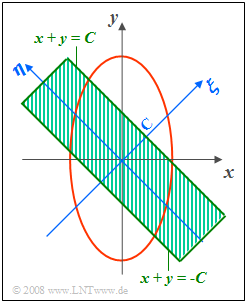Exercise 4.6: Coordinate Rotation
From LNTwww
In the exercise we consider a two-dimensional Gaussian random variable $(x,\hspace{0.08cm} y)$ with statistically independent components. Let the standard deviations of the two components be $\sigma_x = 1$ and $\sigma_y = 2$.
We want to calculate the probability that the two-dimensional random variable $(x,\hspace{0.08cm} y)$ lies within the shaded area:
- $$-C \le x + y \le +C.$$
Perform a coordinate transformation to solve:
- $$\xi = \hspace{0.4cm} x +y,$$
- $$\eta= -x +y .$$
This corresponds to a rotation of the coordinate system by $45^\circ$.
- From $x+y= \pm C$ it thus follows $\xi=\pm C$.
- The two two-dimensional density functions are then:
- $$f_{xy} (x,\hspace{0.08cm}y) = \frac{1}{4 \pi} \cdot \exp \left [ - ( x^2\hspace {-0.1cm} /2 + y^2\hspace {-0.1cm} /8) \right ] ,$$
- $$f_{\xi\eta} (\xi,\hspace{0.08cm} \eta) = \frac{1}{2 \pi \cdot \sigma_\xi \cdot \sigma_\eta \cdot \sqrt{1 - \rho_{\xi\eta}^2}} \cdot \exp \left [ - \frac{1}{2 \cdot (1 - \rho_{\xi\eta}^2)} \cdot ( \frac {\xi^2}{\sigma_\xi^2} + \frac {\eta^2}{\sigma_\eta^2 }- 2 \rho_{\xi\eta}\cdot \frac {\xi \cdot \eta}{\sigma_\xi \cdot \sigma_\eta}) \right ] .$$
Hints:
- The exercise belongs to the chapter Two-dimensional Gaussian Random Variables.
- Reference is also made to the chapter Rotation of the coordinate system.
- Given are the approximations ${\rm Q}(2.3) \approx 0.01$ and ${\rm Q}(2.6) \approx 0.005$ for the complementary Gaussian error function.
- More information on this topic is provided in the (German language) learning video "Gaußsche 2D-Zufallsgrößen":
- Part 1: Gaussian random variables without statistical bindings,
- Part 2: Gaussian random variables with statistical bindings.
Questions
Solution
(1) From $\xi = x + y$ and $\eta = -x + y$ it follows directly:
- $$x = {1}/{2} \cdot ( \xi - \eta ) ,\hspace{0.5cm}y = {1}/{2}\cdot ( \xi +\eta ) .$$
- Substituting these values for the negative exponent, we get:
- $$\frac{x^2}{2} + \frac{y^2}{8} = \frac{1}{8} \cdot ( \xi - \eta )^2 + \frac{1}{32} \cdot ( \xi + \eta )^2.$$
- After Multiplication, this gives:
- $$\frac{5}{32} \cdot \xi^2 + \frac{5}{32} \cdot \eta^2 - \frac{3}{16} \cdot \xi \cdot \eta .$$
- Since the coefficients on $\xi^2$ and $\eta^2$ are equal ⇒ $\sigma_\xi = \sigma_\eta$. The quotient we are looking for is therefore
- $$\sigma_\xi/\sigma_\eta\hspace{0.15cm}\underline{= 1.}$$
(2) By comparing coefficients, we obtain for $\sigma_\xi = \sigma_\eta$ the system of equations:
- $$2 \cdot \sigma_\xi^2 \cdot (1 - \rho_{\xi\eta}^2)= \frac{32}{5},$$
- $$\frac{\sigma_\xi^2 \cdot (1 - \rho_{\xi\eta}^2)}{\rho_{\xi\eta}}= \frac{16}{3}.$$
- Substituting the first equation into the second, we get $\rho_{\xi\eta}\hspace{0.15cm}\underline {= 0.6}$ and $\sigma_{\xi} = \sqrt{5}\hspace{0.15cm}\underline {= 2.236}$.
(3) After coordinate transformation, we can write für this probability:
- $${\rm Pr} ( | x + y | \le C ) = {\rm Pr} ( | \xi | \le C ) = 1 - 2 \cdot {\rm Pr} ( \xi >C ).$$
- With the complementary Gaussian error function, it further follows:
- $${\rm Pr} ( | x + y | \le C ) = 1 - 2 \cdot {\rm Q} ( {C}/{\sigma_\xi}) = 0.99 \hspace{0.3cm} \Rightarrow \hspace{0.3cm} {\rm Q} ( {C}/{\sigma_\xi}) = 0.005.$$
- With the given value ${\rm Q}(2.6) \approx 0.005$ we thus obtain the result:
- $$C \approx 2.6 \cdot \sigma_{\xi}\hspace{0.15cm}\underline {= 5.814}.$$
